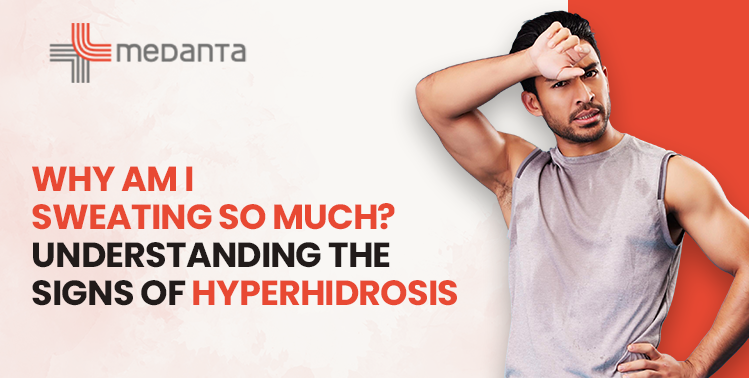CH Baktawar Singh Rd, Medicity, Islampur Colony, Sector 38, Gurugram, Haryana 122001

29 May, 2025
adminHave you ever wondered, “Why am I sweating so much?” If you find yourself sweating more than usual, even when it’s not hot or you’re not working out, it might not just be in your head. You could be experiencing a condition called hyperhidrosis. This condition causes excessive sweating, and it affects millions of people around the world.
In this Harsh Vardhan Puri blog, we’ll explore what hyperhidrosis is, what causes it, the symptoms to watch for, and the difference between primary hyperhidrosis and secondary hyperhidrosis. We’ll also talk about how to manage it and when to see a doctor.
Hyperhidrosis is a medical condition where a person sweats much more than the body needs to regulate temperature. While sweating is a natural and healthy function, people with hyperhidrosis produce sweat in larger amounts and at unexpected times. For example, you might sweat while sitting in a cool room or even during sleep.
Sweating can affect your hands, feet, underarms, face, or other areas. It can be uncomfortable and, for many people, embarrassing. In severe cases, it can interfere with everyday activities like shaking hands, using a pen, or even turning a doorknob.
If you’re asking yourself this question, you’re not alone. There are many reasons you might be sweating more than usual. Sometimes it’s due to temporary causes like heat, stress, or physical activity. But if you find yourself sweating without any clear reason, it might be time to think about whether you have hyperhidrosis.
People often notice symptoms of hyperhidrosis during their teenage years, but it can start at any age. If the sweating feels extreme and uncontrollable, it’s important to pay attention to your body and seek help if needed.
There are two main types of hyperhidrosis, and they each have different causes. These are called primary hyperhidrosis and secondary hyperhidrosis.
Primary hyperhidrosis is the most common type. It usually starts during childhood or adolescence and affects specific areas of the body, like the hands, feet, underarms, or face. The exact cause isn’t fully understood, but experts believe it may be related to overactive nerves that control sweat glands.
Primary hyperhidrosis is not linked to any other health condition. It often runs in families, so if you have a relative who sweats a lot, you may have inherited it. People with this type of hyperhidrosis are usually healthy otherwise, but the excessive sweating can still be very disruptive to their daily lives.
Secondary hyperhidrosis is caused by an underlying medical condition or a side effect of medication. It usually affects larger areas of the body and can happen during sleep as well.
Some possible causes of secondary hyperhidrosis include:
Because this type of sweating is linked to other health issues, it’s very important to talk to a doctor if you suddenly start sweating more than usual, especially if it’s happening all over your body or at night.
The most obvious symptom of hyperhidrosis is excessive sweating that doesn’t match your environment or activity level. You might notice:
Some people also develop skin problems, like irritation or infections, because of constant moisture.
Living with hyperhidrosis can be challenging. People with this condition often feel embarrassed or frustrated. It can affect social interactions, school, work, and even mental health. Some people avoid handshakes, social events, or physical touch because of their sweating.
It’s not just a cosmetic issue. Hyperhidrosis can cause real discomfort and emotional distress. That’s why it’s so important to take it seriously and explore treatment options.
If you think you may have hyperhidrosis, it’s a good idea to speak with a healthcare provider. They will ask about your medical history and symptoms and may run some tests to rule out underlying conditions, especially in cases of secondary hyperhidrosis.
Your doctor might ask questions like:
In some cases, they may do a “sweat test” or blood tests to help figure out the cause.
There are several treatment options for managing hyperhidrosis. The right choice depends on how severe your symptoms are and what type of hyperhidrosis you have.
Here are some common treatments:
Over-the-counter or prescription antiperspirants containing aluminum chloride can block sweat glands and reduce sweating.
Oral medications like anticholinergics can help reduce sweating, though they can have side effects like dry mouth or blurred vision.
Botox can be injected into areas like the underarms, hands, or feet to block the nerves that trigger sweat glands. Results usually last several months.
This treatment involves using a device that passes a mild electrical current through water to reduce sweating, especially on the hands and feet.
In severe cases, surgery may be recommended. One option is removing sweat glands from the underarms. Another is cutting the nerves responsible for triggering sweat (a procedure called sympathectomy).
You can also make changes to help manage symptoms, such as:
If you find yourself constantly asking, “Why am I sweating so much?” it might be more than just normal sweating. Hyperhidrosis is a real medical condition that affects many people, and it’s nothing to be ashamed of. Whether it’s primary hyperhidrosis or secondary hyperhidrosis, help is available.
Understanding the symptoms of hyperhidrosis and its causes is the first step toward getting relief. Talk to your doctor, explore your options, and don’t let excessive sweating control your life. With the right care, you can take back your confidence and feel more comfortable in your own skin.
Category : Hyperhidrosis
Tags: